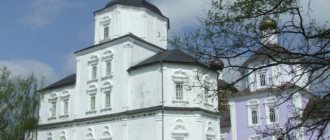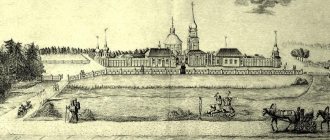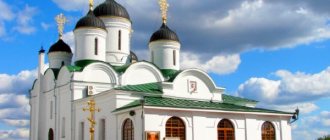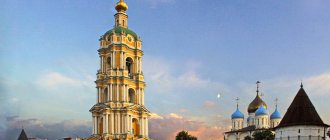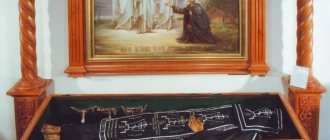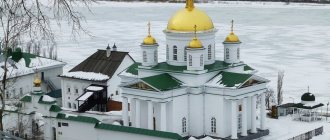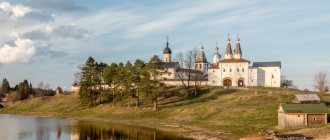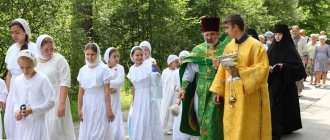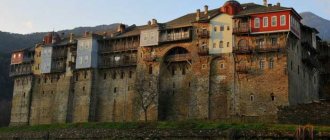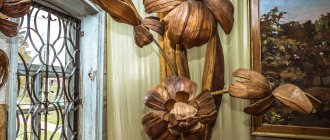Mir
Russia Novgorod region Veliky Novgorod St. George's Monastery (Veliky Novgorod) Map is loading…
{"format":"leaflet","minzoom":false,"maxzoom":false,"limit":50,"offset":0,"link":"all","sort":[""], "order":[],"headers":"show","mainlabel":"","intro":"","outro":"","searchlabel":"\u2026 \u0441\u043b\u0435\ u0434\u0443\u044e\u0449\u0438\u0435 \u0440\u0435\u0437\u0443\u043b\u044c\u0442\u0430\u0442\u044b","default":"","import-annotation":false,"width ":"auto","height":"350px","centre":{"text":"","title":"""link":"""lat":58.48721900000000317731974064372479915618896484375,"lon": 31.28383900000000039653968997299671173095703125,"icon":""},"title":"","label":"","icon":"","lines":[],"polygons":[], "circles":[ ],"rectangles":[],"copycoords":false,"static":false,"zoom":8,"defzoom":14,"layers":["OpenStreetMap"],"image layers":[] ,"overlays":[],"resizable":false,"fullscreen":true,"scrollwheelzoom":true,"cluster":false,"clustermaxzoom":9,"clusterzoomonclick":true,"clustermaxradius":80, "clusterspiderfy":true,"geojson":"","clicktarget":"","showtitle":true,"hidenamespace":false,"template":"","userparam":"","activeicon": "","pagelabel":false,"ajaxcoordproperty":"","ajaxquery":"","locations":[{"text":"\u003Cb\u003E\u003Ca href=\"/palomnik/%D0% A1%D0%B2%D1%8F%D1%82%D0%BE-%D0%AE%D1%80%D1%8C%D0%B5%D0%B2_%D0%BC%D1%83%D0%B6 %D1%81%D0%BA%D0%BE%D0%B9_%D0%BC%D0%BE%D0%BD%D0%B0%D1%81%D1%82%D1%8B%D1%80%D1 %8C_(%D0%92%D0%B5%D0%BB%D0%B8%D0%BA%D0%B8%D0%B9_%D0%9D%D0%BE%D0%B2%D0%B3%D0% BE%D1%80%D0%BE%D0%B4)\» title=\»\u0421\u0432\u044f\u0442\u043e-\u042e\u0440\u044c\u0435\u0432 \u043c\u0443\u0436\u0441\ u043a\u043e\u0439 \u043c\u043e\u043d\u0430\u0441\u0442\u044b\u0440\u044c (\u0412\u0435\u043b\u0438\u043a\u0438\u0439 \u041d\u 043e\u0432\u0433\u043e\u0440 \u043e\u0434)\»\u003E\u0421\u0432\u044f\u0442\u043e-\u042e\u0440\u044c\u0435\u0432 \u043c\u0443\u0436\u0441\u043a\u043e\u04 39\u043c\u043e\u043d \u0430\u0441\u0442\u044b\u0440\u044c (\u0412\u0435\u043b\u0438\u043a\u0438\u0439 \u041d\u043e\u0432\u0433\u043e\u0440\u043e\ u0434)\u003C/a\u003E \u003C/b\u003E\u003Chr /\u003E\u003Ca href=\"/palomnik/%D0%A1%D0%B2%D0%BE%D0%B9%D1%81%D1%82%D0%B2%D0 %BE:%D0%90%D0%BD%D0%BD%D0%BE%D1%82%D0%B0%D1%86%D0%B8%D1%8F\» title=\»\u0421\u0432\ u043e\u0439\u0441\u0442\u0432\u043e:\u0410\u043d\u043d\u043e\u0442\u0430\u0446\u0438\u044f\u003E\u0410\u043d\u043d\u043e\u 0442\u0430\u0446\u0438 \u044f\u003C/a\u003E: \u043e\u0434\u0438\u043d \u0438\u0437 \u0434\u0440\u0435\u0432\u043d\u0435\u0439\u0448\u0438\u0445 \u 043c\u043e\u043d\u0430\ u0441\u0442\u044b\u0440\u0435\u0439 \u0420\u043e\u0441\u0441\u0438\u0438. \u041e\u0441\u043d\u043e\u003Cspan class=\"smw-highlighter\" data-type=\"2\" data-state=\"persistent\" data-title=\"\u0418\u043d\u0444\ u043e\u0440\u043c\u0430\u0446\u0438\u044f\" title=\"\u043e\u0434\u0438\u043d \u0438\u0437 \u0434\u0440\u0435\u0432\u043d\u0435\u0 439\u0448\u0438\ u0445 \u043c\u043e\u043d\u0430\u0441\u0442\u044b\u0440\u0435\u0439 \u0420\u043e\u0441\u0441\u0438\u0438. 1030 1030 1030 1030 1030 1030 \u0440\u043e\u0441\u043b\u0430\ u0432\u043e\u043c\u041c\u0443\u0434\u0440\u044b\u043c. \u0412 \u043f\u0440\u043e\u0448\u043b\u043e\u043c \u2014 \u0434\u0443\u0445\u043e\u0432\u043d\u044b\u0439 \u0446\u0435\u043 d\u0442\u0440\u041d\u043e\u0432 \u0433\u043e\u0440\u043e\u0434\u0441\u043a\u043e\u0439 \u0440\u0435\u0441\u043f\u0443\u0431\u043b\u0438\u043a\u0438, \u043d \u044b\u043d\u0435 \u2014\ u0434\u0435\u0439\u0441\u0442\u0432\u0443\u044e\u0449\u0438\u0439 \u043c\u0443\u0436\u0441\u043a\u043e\u0439 \u043c\u043e\u0 43d\u0430\u0441\u0442\u044b\ u0440\u044c \u0420\u0443\u0441\u0441\u043a\u043e\u0439 \u041f\u0440\u0430\u0432\u043e\u0441\u043b\u0430\u0432\u043d\u043e\u0 439\u0426\u0435\u0440\u043a\ u0432\u0438. \u041d\u0430\u0445\u043e\u0434\u0438\u0442\u0441\u044f \u0432 5 \u043a\u043c \u043e\u0442 \u0412\u0435\u043b\u0438\u043a\u0 43e\u0433\u043e\u041d\u043e\ u0432\u0433\u043e\u0440\u043e\u0434\u0430 \u043d\u0430 \u0431\u0435\u0440\u0435\u0433\u0443 \u0440\u0435\u043a\u0438 \u0412\ u043e\u043b\u0445\u043e\u0432\ u0432\u0431\u043b\u0438\u0437\u0438 \u043e\u0437\u0435\u0440\u0430 \u0418\u043b\u044c\u043c\u0435\u043d\u044c. \u041f\u0440\u0438 \u043c\u043e\u043d\u0430\u0441\u0442\u044b\u0440\u0435 \u0434\u0435\u0439\u0441\u0442\u0432\u0443\u0435\ u0442\u0442\u0440\u0430\u043f \u0435\u0437\u043d\u0430\u044f \u0438 \u0433\u043e\u0441\u0442\u0438\u043d\u0438\u0446\u0430.\"\u003E\u003Cspan class=\"smwtext\"\u00 3E\u2026\u003C /span\u003E\u003Cspan class=\»smwttcontent\»\u003E\u043e\u0434\u0438\u043d \u0438\u0437 \u0434\u0440\u0435\u0432\u043d\u0435\u0439\u0448\u0 438\u0445\u043c\ u043e\u043d\u0430\u0441\u0442\u044b\u0440\u0435\u0439 \u0420\u043e\u0441\u0441\u0438\u0438. 1030 1030 1030 1030 1030 1030 \u0440\u043e\u0441\u043b\u0430\ u0432\u043e\u043c\u041c\u0443\u0434\u0440\u044b\u043c. \u0412 \u043f\u0440\u043e\u0448\u043b\u043e\u043c \u2014 \u0434\u0443\u0445\u043e\u0432\u043d\u044b\u0439 \u0446\u0435\u043 d\u0442\u0440\u041d\u043e\u0432 \u0433\u043e\u0440\u043e\u0434\u0441\u043a\u043e\u0439 \u0440\u0435\u0441\u043f\u0443\u0431\u043b\u0438\u043a\u0438, \u043d \u044b\u043d\u0435 \u2014\ u0434\u0435\u0439\u0441\u0442\u0432\u0443\u044e\u0449\u0438\u0439 \u043c\u0443\u0436\u0441\u043a\u043e\u0439 \u043c\u043e\u0 43d\u0430\u0441\u0442\u044b\ u0440\u044c \u0420\u0443\u0441\u0441\u043a\u043e\u0439 \u041f\u0440\u0430\u0432\u043e\u0441\u043b\u0430\u0432\u043d\u043e\u0 439\u0426\u0435\u0440\u043a\ u0432\u0438. \u041d\u0430\u0445\u043e\u0434\u0438\u0442\u0441\u044f \u0432 5 \u043a\u043c \u043e\u0442 \u0412\u0435\u043b\u0438\u043a\u0 43e\u0433\u043e\u041d\u043e\ u0432\u0433\u043e\u0440\u043e\u0434\u0430 \u043d\u0430 \u0431\u0435\u0440\u0435\u0433\u0443 \u0440\u0435\u043a\u0438 \u0412\ u043e\u043b\u0445\u043e\u0432\ u0432\u0431\u043b\u0438\u0437\u0438 \u043e\u0437\u0435\u0440\u0430 \u0418\u043b\u044c\u043c\u0435\u043d\u044c. \u041f\u0440\u0438 \u043c\u043e\u043d\u0430\u0441\u0442\u044b\u0440\u0435 \u0434\u0435\u0439\u0441\u0442\u0432\u0443\u0435\ u0442\u0442\u0440\u0430\u043f \u0435\u0437\u043d\u0430\u044f \u0438 \u0433\u043e\u0441\u0442\u0438\u043d\u0438\u0446\u0430.\u003C/span\u003E\u003C/span\u003E \u043c\u043e\u043d\ u0430\u0441\u0442\u044b\u0440\u0435 \u0434\u0435\u0439\u0441\u0442\u0432\u0443\u0435\u0442 \u0442\u0440\u0430\u043f\u0435\u0 437\u043d\u0430\u044f\u0438\ u0433\u043e\u0441\u0442\u0438\u043d\u0438\u0446\u0430.","title":"\u0421\u0432\u044f\u0442\u043e-\u042e\u0440\u044c\u0435\u0432 \u 043c\u0443 \u0436\u0441\u043a\u043e\u0439 \u043c\u043e\u043d\u0430\u0441\u0442\u044b\u0440\u044c (\u0412\u0435\u043b\u0438\u043a\u0438\ u0439\u041d\u043e\u0432\ u0433\u043e\u0440\u043e\u0434)","link":"","lat":58.48721900000000317731974064372479915618896484375,"lon":31.2838390000000003965396899 7299671173095703125,"icon":""}],,"imageLayers":[]}
58.487219; 31.283839
Russia, Veliky Novgorod, Yuryevskoe highway, 10
Veliky Novgorod, Novgorod region 173007
Russia
Telephone:
8 (8162) 77-30-20
Email:
St. Yuryev Monastery
- one of the oldest monasteries in Russia. Founded in 1030 by Prince Yaroslav the Wise. In the past it was the spiritual center of the Novgorod Republic, now it is a functioning monastery of the Russian Orthodox Church. It is located 5 km from Veliky Novgorod on the banks of the Volkhov River near Lake Ilmen. There is a refectory and a hotel at the monastery.
History[edit]
According to legend, it was founded in 1030 by Prince Yaroslav the Wise. Yaroslav Vladimirovich in holy baptism bore the name George; in Russian the latter usually took the form "Yuri", hence the name of the monastery. The first chronicle mention dates back to 1119.
The monastery's buildings were originally wooden, like its cathedral church of St. George. In 1119, by order of Prince Mstislav the Great, a stone temple was laid - St. George's Cathedral, built by master Peter - the first Russian architect, whose name is named in the chronicles.
In 1125 Mstislav inherited the throne of Kiev. Having already become a Grand Duke, he married the daughter of a Novgorod mayor. In 1130, he endowed the Yuryev Monastery with significant land holdings. The letter of complaint, written on parchment on behalf of Mstislav and his son Vsevolod, the oldest surviving Russian legal document, is kept in the Novgorod Museum. During the restoration of the monastery in the 1990s, an inscription was discovered on the plaster (in everyday graphics) about the visit of Mstislav the Great (baptized Theodore) to the Yuryev Monastery on his name day: “The horse was on Theodore’s day Mstislavo.”
The walls of the Yuryev Monastery were first mentioned in the chronicle of 1333.
In the XII-XIII centuries, the monastery became the state monastery of the Novgorod Republic, and its head, the Novgorod archimandrite, became the head of the city magistrates. By the end of the 15th century, the Yuriev Monastery was one of the richest church feudal lords.
After the secularization of the monastery estates in the 1770s, the monastery lost a significant part of its possessions and fell into disrepair.
In 1822, Archimandrite Photius (Spassky), who enjoyed the favor of Alexander I, became the head of the monastery. He was also favored by Countess Anna Orlova-Chesmenskaya (daughter of Count Alexei Orlov-Chesmensky), one of the richest landowners in Russia. With the help of the latter, extensive restoration and construction work began in the monastery. In a short time, the following buildings were built: the Western building with the Church of All Saints, the Spassky Cathedral, the eastern Oryol building with cells for the brethren, the northern with the Church of the Exaltation of the Cross, the southern with the hospital Church of the Burning Bush. In 1841, the bell tower was built according to the design of the architect Carl Rossi.
In 1921, a decision was made to expropriate the property and valuables of the monastery. In the fall of 1924, there were six churches in Yuryev, but by 1928 there was only one church left - the Exaltation of the Cross. In the early 1930s, for some time, services were held in one of the premises of the Archimandrite Corps. From 1932 to September 1941, the complex of buildings housed a nursing home named after. Sverdlov.
During the Great Patriotic War, German and Spanish military units, as well as units of Baltic collaborators, in particular the Lithuanian Wehrmacht police battalion, were located here. During these years, the monastery buildings suffered serious damage.
After the war and until the end of the 1980s, people lived on the territory of the monastery, there was a post office, a technical school, a technical school, a museum, a grocery store and an art salon.
On December 25, 1991, the complex of monastery buildings was transferred to the jurisdiction of the Novgorod diocese. In 1995, a monastic community was created.
Currently, services are held in 4 churches of the monastery: St. George's Cathedral, Holy Cross Cathedral, Spassky Cathedral (Church of the Nativity), and the Church of the Burning Bush Icon of the Mother of God.
In 2005, the Holy Synod, at the request of Archbishop Lev of Novgorod, blessed the opening of a theological school in the monastery, with the appointment of Archbishop Lev as its rector.
Contemporary activities of the parish
The monastery, despite its active activities, does not have a large number of brethren - in some years their number reached only 4 people. The brotherhood is led by Archimandrite Lev. Divine services are regularly held on the territory of 4 churches of the monastery, some of them are not heated and it can be difficult to attend services in the winter season.
Since 2005, a Theological Seminary was opened on the territory, which since 2015 has been called “Diocesan Theological Courses” and is managed by Archimandrite Leo. On the territory of the monastery there is a large apple orchard, which is looked after by parishioners and monks.
Divine service at St. George's Monastery
For pilgrims, entry to the monastery territory is free, but donations are highly desirable, which go towards the reconstruction and maintenance of the cultural heritage. In addition to the services, pilgrims can stay in a hotel on the territory and explore the area for several days, especially since the surrounding landscapes are conducive to this (there is even a beach near the monastery). There is also a refectory for tourists, which is served by the brethren.
Monastery buildings[edit]
- St. George's Cathedral
Construction of the cathedral, which became the main temple of the Yuryev Monastery, began in 1119. The initiator of the construction was Grand Duke Mstislav I Vladimirovich. From the Novgorod Chronicle we know the name of the builder of the cathedral - master Peter, who allegedly also built the St. Nicholas Cathedral and the Church of the Annunciation on the Settlement. This is the first of the famous names of ancient Russian master builders. Construction of the cathedral lasted 11 years. On July 12, 1130, it was consecrated in the name of St. George the Victorious by Novgorod Bishop John.
The cathedral became the tomb of the abbots of the monastery, a number of Russian princes and Novgorod mayors. In 1198, Izyaslav and Rostislav, the sons of the Novgorod prince Yaroslav Vladimirovich, were buried in it; in 1203, the Novgorod mayor Miroshka Nesdinich, who took monastic vows at the monastery; in 1233 - Prince Fyodor Yaroslavich, the elder brother of Alexander Nevsky, and in 1224 his mother Feodosia Mstislavna (in monasticism Euphrosyne); in 1453 - Dmitry Yuryevich Shemyaka.
In the 1820-30s, the cathedral was restored, during which the frescoes of the 12th century were almost completely destroyed (the original fresco painting (fragments of the saint's order) was preserved only on the slopes of the windows and in the upper part of the staircase tower, where the small church was located). The cathedral was completely re-painted. In 1898, new frescoes were knocked down during regular renovation work. In 1902, the restored cathedral was consecrated by Archbishop Gury of Novgorod and Staraya Russia.
In 1929, the Yuriev Monastery was closed, services in St. George's Cathedral were stopped. The cathedral and monastery were returned to the Russian Orthodox Church in 1991; since this period, services have been held in St. George's Cathedral.
In 2014, under the floor of the cathedral, fragments of fresco painting from the 12th century, knocked down under Archimandrite Photius, were discovered, including ancient graffiti (about the death of Archbishop Anthony (Dobrynya Yadrejkovic) in 1232, the sons of Prince Yaroslav Vladimirovich in 1198 and the fire of the Trinity Church 1160), work began on collecting fragments and reconstructing the frescoes.
- Holy Cross Cathedral
The temple in honor of the Exaltation of the Precious and Life-Giving Cross of the Lord is located on the north-eastern corner of the monastery. The cathedral was built in 1823 under Archimandrite Photius, on the remains of an unnamed church that burned down in 1810, which was built in 1761.
It has 5 blue chapters, on which 208 eight-pointed stars are placed. After the monastery was closed by the Bolsheviks, the temple eventually lost its wall paintings, and currently does not have any. The interior walls are painted white. During the Soviet years, the cathedral housed alternately a museum, a post office, and a warehouse; in 1990-91. art gallery of local artists. In the summer of 2004, the wooden frames and metal cladding of all five domes and crosses were replaced. The cathedral has a heating system and is used for regular services in both summer and winter.
- Spassky Cathedral
Located to the north-west of St. George's Cathedral, the wings of the Archimandrite Corps are closely adjacent to it from the north and south.
In 1763, a stone church of Alexander Nevsky and his brother Fyodor was built a few meters west of St. George's Cathedral. The customer of the temple was Archimandrite Ioannikis I of the monastery. In 1823, this church burned down during a strong fire. In 1823-1824. On the foundation of the old church, using old masonry, the Spassky Cathedral was built. The customer of the temple is Archimandrite Photius. The cathedral was built with two chapels: St. Anna and Photius and Anicetas. In 1830, according to the design of the Novgorod provincial architect, a porch was added to the cathedral on the western side. In 1836, the Church of the Praise of the Virgin Mary was built in the basement of the cathedral. Later, Archimandrite Photius and the monastery’s benefactor Anna Orlova-Chesmenskaya were buried in it. In 1841, the chapel of All Saints was added to the south, which directly adjoined the chapel of St. Anne. In 1848-1849 the cathedral was renovated. In 1850, another chapel was added to the north - Alexy Metropolitan of Moscow, adjoining the chapel of Photius and Anikita. The customer of the buildings was Archimandrite Manuil Monastery.
In 1936, under the leadership of the architectural historian and archaeologist M.K. Karger, the domes and drums were dismantled, as they extinguished the dominant image of the monastery - St. George's Cathedral.
The cathedral was also damaged during the Great Patriotic War. Restored in 1954-56. In 2004-07, the drums were rebuilt and the domes with crosses were restored.
The monument is an ordinary building of the 19th century, designed in the forms of provincial classicism. The layout and nature of the vaulted ceilings may be of interest.
- Bell tower
It is a four-tier building with a height of 52 meters. Erected in 1838-41 by the architect Sokolov according to the design of Carlo Rossi. Construction was carried out after the death of Archimandrite Photius, and Countess Anna Orlova financed the work. The bell tower has a noticeable disproportion between its parts. There is a legend on this score, according to which Nicholas I deleted the middle tier from the project so that the building would not exceed the height of the Ivan the Great bell tower in the Moscow Kremlin.
Previously, there was a clock on the bell tower (in a round niche in the upper tier). The time was struck by 17 bells connected to them (third tier). Below were 15 more bells. The largest monastery bell was called “The Burning Bush” and weighed 2,100 poods (33.6 tons). The second largest is “Cross” - 1140 poods (18.2 tons). In the 2002–03 winter season, mobile communication antennas were installed on the upper tier of the bell tower. The last large-scale restoration took place in 2009.
- Church of the Icon of the Mother of God “Burning Bush”
The monastery often suffered from fires, and by order of Archimandrite Photius, this church was founded in 1828 in honor of this icon, considered in Orthodoxy to protect against fires. It is possible to enter the church only through the corridor of the “Southern” building, bypassing the cells of the monks. The church has heating, but is currently used only for services on holidays and prayer services for residents. Unlike pilgrims, mass tourists are not allowed access to this part of the monastery.
- Church of the Archangel Michael
Located in the south-eastern tower of the monastery fence. The tower itself was built in 1760. The church was built in 1831 under Archimandrite Photius. During the battles for Novgorod in 1941-44, it was completely destroyed. In the 1950s, the shape of the building was restored. In 2010–13, the drum and dome of the temple were restored. Restoration of the interior decoration is expected.
Plan of the Yuryev Monastery
1.
St. George's Cathedral.
1119-1130 2.
Remains of the refectory.
1540 (archaeol.) 3.
Gate Church of the Transfiguration.
XII century (archaeol.) 4.
Holy Cross Cathedral.
1760—1781, 1823 5.
Northern building (cells of the governor, treasurer, sacristan and steward).
1760, 1811-1828 6.
Archimandrite (abbot) and refectory buildings.
1762-1768, 1823-1828 7.
Spassky Cathedral.
1763, 1823-1824 8.
Bell tower.
1838-1841 9.
Coach house.
XIX century 10.
Northwestern (Horse) Tower.
1828-1830 11.
Western Gate.
1829-1833 12.
Stable.
1819-1826 13.
Western Fraternal Corps.
XIX century 14.
Western fence.
XIX century 15.
Sewing workshop.
1829-1833 16.
Southwestern Tower.
1828-1829 17.
Hospital cells.
1828-1829 18.
Church of the Burning Bush.
1828-1830 19.
Metropolitan's chambers.
1829-1832 20.
South-eastern tower (Church of St. Michael the Archangel) XVIII century.
1834-1835 21.
Swan body.
XVIII century, 1824 22.
Hotel building.
XVIII, XIX centuries 23.
Eastern (Holy) Gate.
1824 24.
Carpentry and metalworking workshops.
XIX century 25.
Eastern fence.
XIX century 26.
Oryol building.
1825-1827 27.
Granite ciborium. XVI century
Patronal holidays[edit]
St. George the Victorious, Great Martyr
- the 6th of May
Exaltation of the Life-Giving Cross of the Lord
- September 27
Icon of the Blessed Virgin Mary “Burning Bush”
— September 17
Michael, Archangel
— September 19 (memory of the miracle in Khoneh), November 21 (cathedral)
St. George's Cathedral
Many churches are located on the territory of the city of Veliky Novgorod. Yuryev Monastery includes several churches.
The main one is St. George's Cathedral. Its construction was initiated in 1119. The church was built by Master Peter. He was one of the first ancient Russian masters, and one of the few whose name has survived to our time. Construction lasted for 11 years. In 1130 it was consecrated in the name of St. George the Victorious. The abbots of the monastery, some Russian princes and Novgorod mayors are buried here.
The style of the cathedral is impeccably logical. Its forms have material weight. It’s as if he was created for a princely exit, and not at all for a transition to contemplation and self-deepening. This reflects the character of the temple and its purpose. After all, it was originally built not only as the main cathedral of the monastery, but also as a princely church.
The exterior of the cathedral and the interior decoration are grandiose. However, it is distinguished by a large number of monotonous niches and windows, which are arranged in belts. Despite this grandeur, the architecture of the cathedral is simple. It is lined with stone blocks and bricks. The roof has four slopes. Previously, it was covered with lead sheets and was distinguished by its originality. Three chapters, arranged asymmetrically, form the crown of the temple.
The walls of the cathedral were painted shortly before the consecration. But, unfortunately, at present the ancient fresco painting is almost completely destroyed. Only minor fragments remain that decorate the window slopes, as well as ornamental decorations. But the ancient painting was preserved in a small temple, which is located in a tower in the northwestern side.
The cathedral amazes with its power and grandeur. Since the walls of the church are very thick, it is always cold there. However, it works. According to the monastery charter, divine services are held here. The brethren are still small, but gradually the cathedral is being revived, the temple is being repaired, icons are being painted, and the monastic economy is being organized.
How to get there[edit]
Address:
173007, Veliky Novgorod, Yuryevo microdistrict, Yuryevskoe highway, 10.
Telephone:
8 (8162) 77-30-20
Email:
Website:
https://georg.orthodoxy.ru/
Directions:
Yuriev Monastery is located a few kilometers from Novgorod. To get there, it is best to take bus No. 7 (or No. 7-a), which runs from the station. The stop you need is called “Yuryevo”. If you are traveling by car, you need to leave the city along Trinity Street and follow the main road until the turn to the Yuryev Monastery and Vitoslavlitsy, where, by the way (in the Novgorod Museum of Folk Wooden Architecture), the house of Countess Orlova-Chesmenskaya has been preserved.
The buildings
A whole ensemble of cathedrals and temples makes up the Yuryev Monastery (Veliky Novgorod). A photo of the monastery map hangs at the entrance. Anyone can get acquainted with it. The monastery includes:
- St. George's Cathedral, which is the main temple.
- Holy Cross Cathedral is a beautiful church with blue domes decorated with gold stars.
- Spassky Cathedral.
- The bell tower, which reaches a height of 52 meters, is a visiting card.
- A stone gazebo, where previously there was a consecrated source of water.
- An ancient windmill belongs to the Vitoslavlitsy Museum.
Abbots
- Cyriacus (mentioned 1119 - 1128)
- Isaiah (1128 - 1134)
- ? Jonah (c. 1138)
- Dionysius (1158 - 1194)
- Savvaty (1194 - April 16, 1226)
- Savva, Greek (1226 - March 15, 1230)
- Arseny (1230 - ?)
- Varlaam (? - 1270)
- John (1270 - 1274)
- Kirill (1295 - 1310)
- St. Moses (? - 1325)
- Lawrence (mentioned 1333)
- Joseph (1337 - 1345)
- Nikephoros 1352.
- Savva (mentioned 1375, 76; July 1-29, 1377)
- David (1386)
- Parthenius (1398)
- Varlaam (1408; 1410 - 1419)
- Khariton 1420
- Misail 1449.
- Gregory 1460.
- Theodosius 1476.
- Cassian (1499 - December 1504)
- Jonah I (1517 - 1523)
- Silouan (October 2, 1530 - ?)
- Gury (? - September 15, 1539)
- Cassian (? - 1551)
- Hilarion (1551 - 1553)
- Gennady (Mezhov) (1554 - 1558)
- Bartholomew (July 23, 1558 - 1564)
- Leonidas (November 15, 1567 - 1568/1570)
- Theoktist (September 1571 - August 1572)
- Alexander (? - 1576)
- Misail (January 1580 - 1589)
- Joachim (1589 - 1599)
- Nikander (1606 - 1618)
- Dionysius (1618 - 1632)
- Jonah II (1632 - 1633)
- Gerasim (Putnikov/Kunitsa) (January 1634 - 1635)
- Niphon (March 7, 1635 - 1639)
- Hilarion (1640 - 1660)
- Theodosius (1661 - May 23, 1667)
- Parthenius (1666 - 1672)
- Simeon (1672 - 1676)
- Job (6 June 1676 - 1701)
- Sylvester (Kholmsky-Volynets) (1701 - October 23, 1704)
- Gabriel (Dometsky) (December 1704 - August 1708)
- Isaac (August and October 1708)
- Aaron (Eropkin) (December 27, 1708 - 1723)
- Andronik (1723 - 1725)
- Markell (Radyshevsky) (September 27, 1725 - 1726)
- Aaron (Eropkin), 2 times (January 9, 1728 - 1730)
- Andronik, 2 times (January 20, 1731 - September 4, 1734)
- Joseph (Khvabulov) (August 1734 - October 9, 1740)
- Gabriel (Voronov) (October 18, 1740 - January 24, 1741)
- Markell (Radyshevsky), 2 times (January 24, 1741 - 1742)
- St. Pavel (Konyuskevich) (July 23, 1743 - 1758)
- Joasaph (Khotuntsevsky) (May 31, 1758 - April 29, 1759)
- Ioannikiy (Svyatkovsky-Zverev) (May 1, 1759 - June 3, 1768)
- Ioannikiy (Mikritsky) (August 25, 1768 - May 17, 1775) [1]
- Victor (Onisimov) (May 8, 1775 - July 3, 1782)
- Arseny (Buzanovsky) (May 26, 1782 - 1785)
- St. Afanasy (Volkhovsky) (November 13, 1785 - 1788)
- Iriney (Klementyevsky) (June 30, 1788 - 1792)
- Iakinf (Karpinsky) (June 27, 1792 - April 18, 1795)
- Gervasy (Lintsevsky) (May 6, 1795 - 1796)
- Arseny (Todorsky) (June 21 - August 15, 1796)
- John (Ostrovsky) (August 25, 1796 - September 10, 1797)
- Ambrose (Kelembet) (September 17, 1797 - November 13, 1799)
- Mikhail (Desnitsky) (December 6, 1799 - July 20, 1802)
- Ambrose (Protasov) (June 4, 1802 - 1804)
- Parfeniy (Petrov) (January 12, 1804 - 1809)
- Sergius (Krylov-Platonov) (January 27, 1810 - 1811)
- Ambrose (Ornatsky) (1811 - 1812)
- St. Filaret (Drozdov) (March 27, 1812 - March 1816)
- Vladimir (Uzhinsky) (March 10 - May 11, 1819)
- Damascene (Rossov) (May 27 - December 14, 1819)
- Anatoly (Stavitsky) (February 8, 1820 - August 21, 1822)
- Photius (Spassky) (1822 - February 26, 1838)
- Manuil (Soloviev) (May 1, 1838 - February 8, 1857)
- Varlaam (Denisov) (March 22, 1857 - August 21, 1860)
- Geronty (Artyukhovsky) (1860 - 1865)
- Herman (Ossiecki) (March 3, 1866 - 1867)
- Joachim (1869)
- …
- Ioannikiy (Dyachkov) (1905 - 1907)
- Joseph (Petrovykh) (1907 - February 27, 1909)
- Anatoly (Junger) (February 27, 1909 - October 23, 1910)
- sschmch. Juvenaly (Maslovsky) (October 23, 1910 - 1914)
- Nikodim (Voskresensky) (August 26, 1914 - 1922)
- Sergius (Vasiliev) (1922 - ?)
- 1929-1991 - closed
- since 1991 - the bishops of Novgorod are the priest-archimandrites
Viceroys
- Theodore (Taraskin) (July 17, 1996 - April 19, 2000)
- Arseniy (Perevalov) (since 2008 - mentioned January 10, 2011) acting
Necropolis
The following were buried in St. George's Cathedral:
- Izyaslav Yaroslavich (+ 1198) prince, son of Prince Yaroslav Vladimirovich
- Rostislav Yaroslavich (+ 1198) prince, son of Prince Yaroslav Vladimirovich
- Miroshka Nezdinich (+ 1203) Novgorod mayor
- Dmitro Miroshkinich (+ 1207) son of mayor Miroshka
- Blgv. book Theodore Yaroslavich (+ 1233) - subsequently the relics were transferred to St. Sophia Cathedral
- Holy book Theodosia Mstislavna, in monasticism Euphrosyne (+ 1234) mother of the holy princes. Theodore and Alexander Yaroslavich, near the southern wall of the cathedral
The following were buried in the Church of the Praise of the Blessed Virgin Mary:
- Photius (Spassky) (+ 1838) archimandrite. Yuryevsky
- Anna Alekseevna Orlova-Chesmenskaya (+ 1848) countess-philanthropist
Bell tower
Against the background of all the buildings of the Yuryev Monastery, the bell tower stands out for its height. It consists of 4 tiers. Its height is 52 meters. It was built in 1838-1841. The bell tower was designed by Carlo Rossi. The construction was carried out by the architect Sokolov. If you look at the bell tower directly, you can notice the disproportion of its parts. This is due to the fact that Nicholas the First deleted the middle tier from the project so that the building would not be higher than the bell tower of Ivan the Great in the Kremlin. During Easter week, any tourist can try ringing the bells. This building is clearly visible from a pedestrian bridge in a city like Veliky Novgorod. Yuriev Monastery is easy to distinguish from a distance. The bell tower with a golden dome that literally glows in the sun is the hallmark of the monastery.

